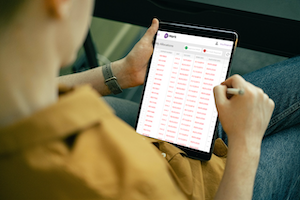The examination marking process presents several operational challenges, particularly for professional membership bodies who still mark physical papers or use spreadsheets to keep on top of all the papers out for marking.
Whether it’s to achieve accreditation or for their continued professional development (CPD), your assessments are an important part of your offering to your members. That’s why it’s vital you have an efficient exam marking structure in place at your professional membership body.
An inefficient exam marking process can lead to:
- Poor candidate experience
- Unreliable or inaccurate marking
- Late papers
- Wasted money and resources
- Poor use of exam administrator’s time
- Wider environmental impact
What Challenges Are You Faced With?
We’ve worked with several qualification providers and we’re always asking about the challenges they’re faced with. Every professional body is different and has their own set of barriers they overcome, such as:
- Tracking down overdue papers
- Losing track of papers and who is marking them
- Manually updating Excel spreadsheets is laborious
- Spreadsheets not always up to date, or contain errors
- Difficulty in re-allocating or moderating physical papers
What challenges do you face with your examination marking process? Have you found effective ways to overcome these? Do they result in added running costs? How do these affect the candidate experience?
One solution that will reform your examination marking process is online exam marking. There are many different on-screen marking tools out there. Some are available off the shelf with a specific set of functions and features, while others are easily customisable to perform new tasks and deliver bespoke reporting.
Manage Rather Than Administrate
Online examination marking software takes the pressure of you and your exam administration teams. There are no more spreadsheets, no more tracking down late marks and no more manually distributing papers.
The membership bodies we speak to who have implemented such technology told us they’ve seen a faster examination marking process, more accurate grades and a significantly reduced administrative burden. They also highlighted scalability with their ability to adapt to future challenges, such as a surge in candidates, marker unavailability or a large-scale disaster which would affect their global offices.
Features to look out for
When choosing which online exam marking to implement, it’s important your final solution hits the whole brief. That’s why we recommend looking beyond off-the-shelf products and exploring customisable options, so you’re not restricted by the system’s functionality.
These are some of the essential features you should look out for in exam marking software:
Automatic Distribution of Papers
Exam marking tools do the hard work for you. It can allocate and distribute scripts to assessors in an instant, taking into account examiner criteria such as their languages, qualifications and availability.
Real-time status of every paper
You no longer need to worry about manually updating a spreadsheet, or data loss because a colleague saved over your shared Excel file.
Through an interactive and user-friendly dashboard, you will see every paper that’s out for marking, who’s marking them and their deadlines. That way you will always have an accurate overview of the process and gain a clear understanding of how many papers are out for marking at any time.
Alerts to overdue papers
As well as showing you all the papers out for marking, online exam tools can also alert you to overdue (or nearly due) papers. From here, you can either speak to the assessor, or:
Re-Allocate in an Instant
The beauty of marking exam papers online is that you can re-allocate papers or send them for moderation with the click of a mouse. With a physical script, this would be a long step involving retrieving the exams from the assessor and delivering them to the moderator or re-allocated assessor. Now, it’s done in a matter of seconds.
Custom Reporting
Professional membership bodies use the reporting functionalities in their online marking software to analyse examiner performance and question performance; this helps them identify areas for improved training where there were low marks across the board, for example. Not only can you run custom reports on whatever it is you want to analyse, these can run automatically and go straight to your inbox.
Integration
The marking of exams isn’t the only step in the assessment lifecycle, and your system needs to be able to receive and share information with your other systems.
As an example, eMarking receives completed papers via an API from your existing exam management system, then sends the results back automatically. Papers can be manually uploaded through a PDF format if required.
Cost and Return on Investment
There are different price points, depending where in the market you look for these types of tools. Some are a one-off cost, while others let you spread the costs out monthly. With such a major decrease in the resource required for administration, you can recover the initial investment cost and start seeing a good return on investment very soon after installing.
Fast, Secure and Scalable
These are just some of the ways moving your assessment marking process online can seriously enhance the overall experience for your examination teams, assessors and your candidates. As well as considerably reducing your workload, online tools give assessors the flexibility to work on any device securely, and makes it easier to achieve a standardisation of marking.
PSP IT Design & Development developed eMarking, a fully-customisable online exam marking tool which completely digitised and streamlined one examination board’s marking process, who said their workload had more than halved thanks to the web-based application.
Are you ready to explore the possibilities of online marking? To see it in action, book a demo by emailing [email protected]. Prices start from just £40 a month per user.










Leave A Comment